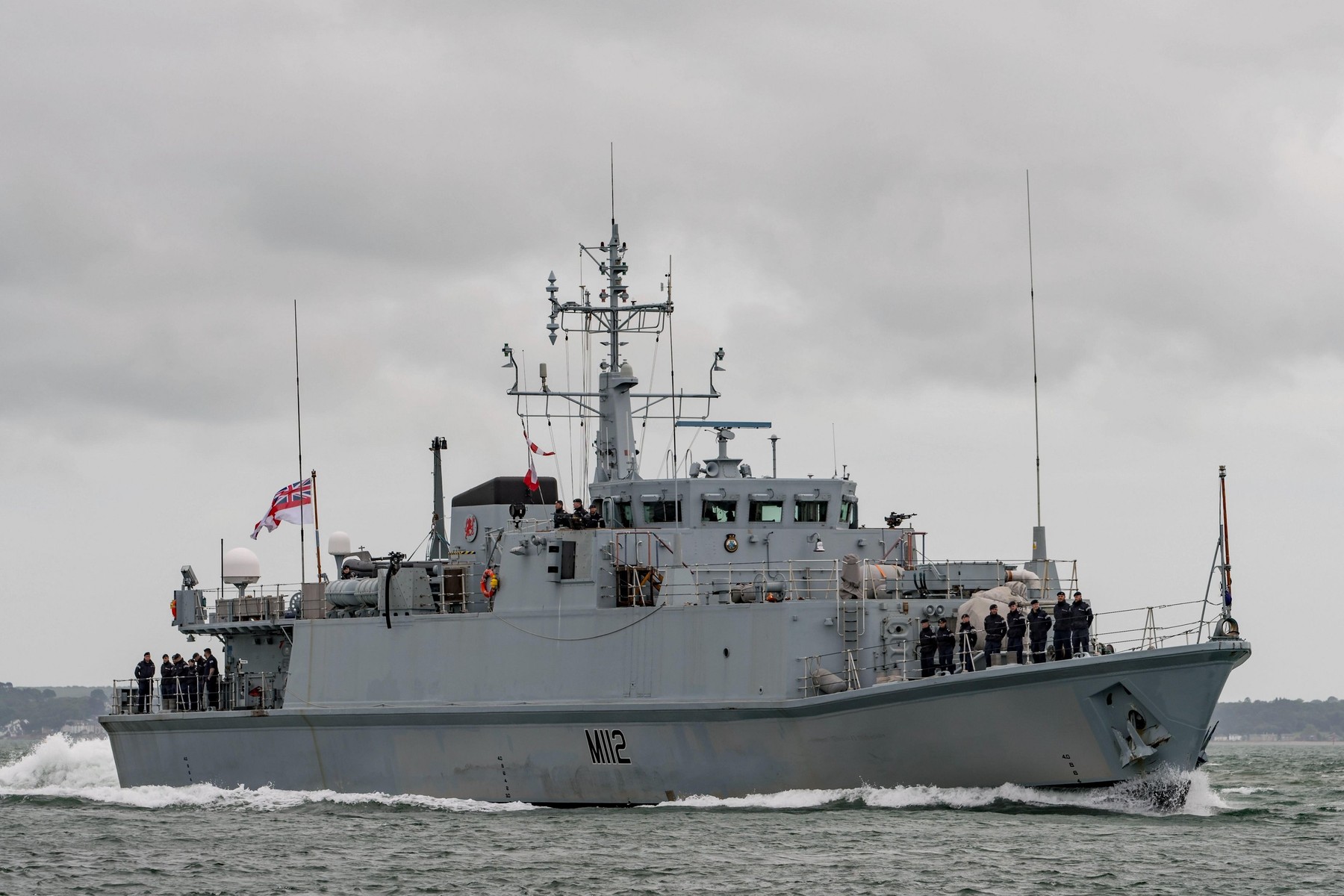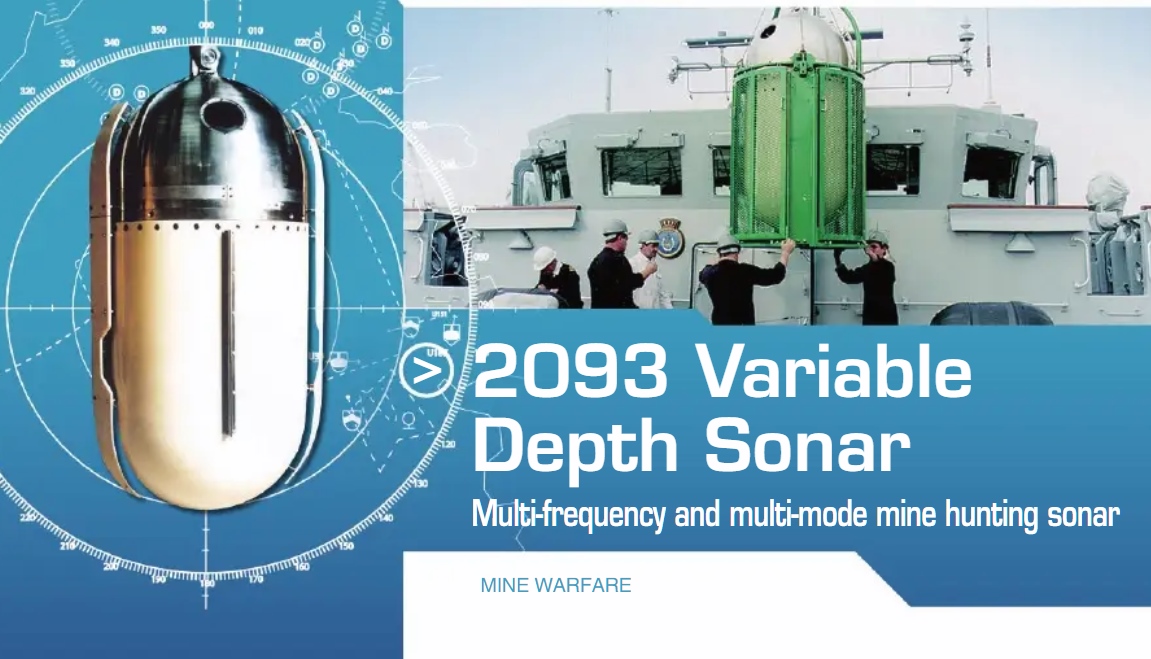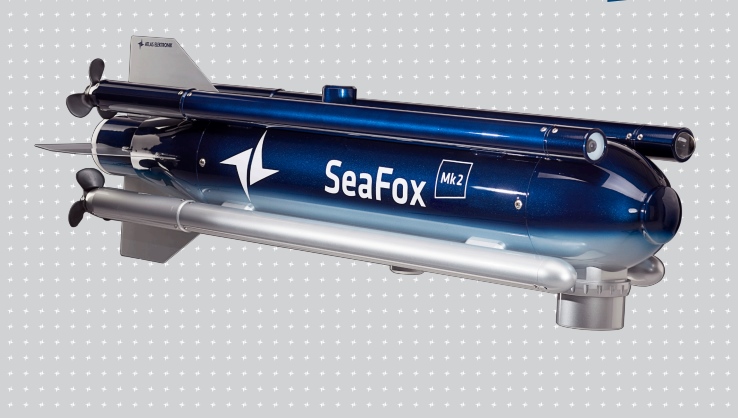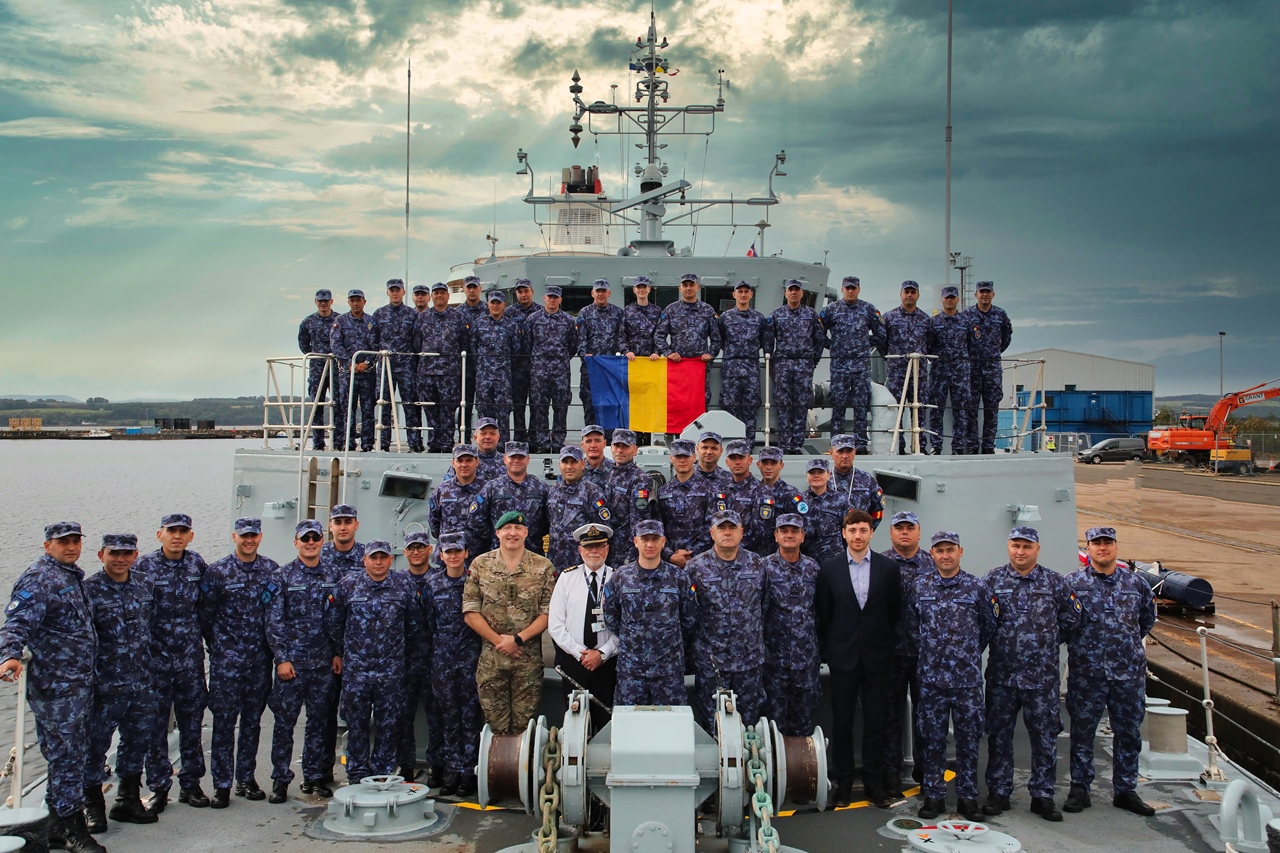
The newest ship of the Romanian Navy, the M270 minesweeper Sub-Lieutenant Ion Ghiculescu – the first of two Sandown-class ships bought from the UK – arrived at the port of Constanta on Tuesday. Despite the fact that it is a used ship, it is equipped with the most modern technologies and will be one of the most modern, but at the same time the newest in the arsenal of the Romanian Navy.
- In the context of the threat of sea mines in the Black Sea, Romania purchased two modernized minesweepers of the Sandown type from Great Britain for approximately EUR 150 million. Two British ships were launched in 1999 and 2000 (M110 Ramsey and M111 Blyth), but they have been modernized and equipped with the latest technology to count in the fight against sea mines.
- Minehunter M 270 “Sublieutenant Ion Ghiculescu”, ex HMS Blyth of the UK Royal Navy, is the first of two minesweepers to arrive in Romania. Mine Hunter docks at the military port of Constanta on Tuesdayafter a 4,500-nautical-mile march that began on November 15 in Great Britain following logistical operations at Babcock Shipyard.
- The ship is operationally compatible with NATO structures, has a displacement of 600 tons, a crew of about 40 soldiers, a length of 52.5 meters, a width of 10.9 meters, a draft of 2.3 meters and is equipped with the capabilities of combating sea mines (MCM). ). The ships are equipped with radar, sonar and small arms systems (30 mm cannon and machine guns) and their main purpose is to survey, detect, classify, track and destroy/neutralize sea mines. Ships are made of non-metallic materials, mostly fiberglass, to avoid attracting traditional sea mines as much as possible.
- On board, the ship relies on three key systems to detect, catalog and defuse mines: Thales 2093 sonar high resolution, broadband and works at variable depths – considered “state of the art”; battle management system M-cube, specially designed for the operation of minesweepers and able to work with autonomous systems; system SeaFox underwater drones with remote control which allow remote identification and neutralization of surface and deep mine-explosive actions. More about these systems below.
The Russian-Ukrainian war has led to an increase in the mine threat in the Black Sea / Romania is moving strategically
Mine action is a field of extreme intensity and danger, and until recently mine action was hardly talked about. Russia’s war in Ukraine has turned the Black Sea into an extremely dangerous place, and the threat of sea mines in the Black Sea has increased significantly.
Since the beginning of the war, more than 150 sea mines have been found in the Black Sea, which can threaten maritime communication. Of these, six such mines were discovered in the coastal zone of Romania and neutralized by the naval forces.
However, Romania still did not have modern means adapted to mine countermeasures. The intervention of Romanian military sailors against drifting mines took place after they had already been spotted, and their neutralization was carried out “manually” by divers from the OVD. During one of the interventions, one of the Romanian ships was even damaged because it came too close to a mine against the background of rough seas.
Precisely because the navy did not have sufficient capacity to respond to these threats, Romania quickly moved and acquired two Sandun-class minesweepers from the UK.
- Romania, Turkey, and Bulgaria are joining a naval group for demining the Black Sea
 Sandown-class minehunter HMS Shoreham / Photo: Neil Watkin / Alamy / Alamy / Profimedia
Sandown-class minehunter HMS Shoreham / Photo: Neil Watkin / Alamy / Alamy / Profimedia
“At the moment, it has been proven that a mine of relatively small value can cause great destruction, can interrupt the movement of ships, and in this context, the need for Romania to increase its anti-mine combat capability was absolutely essential,” he explains. for HotNews.ro Cristian Sfici, CEO of the Romanian company Thales, whose technologies are used in the new minesweepers being equipped by the Romanian Navy.
“Earlier, prospectors were seen as an expense – ‘Why do we need prospectors?’ Where have you seen me, except in World War II?’ – Well, reality showed us that there is a need, that we need such opportunities,” says Sfichi.
Sandown-class ships built from special materials
According to a representative of Thales, the most effective are those systems that have a very small area and an electromagnetic signature.
“From this point of view, Sandown-class ships with a fiberglass keel are among the best anti-mine ships. They don’t attract mines, you can send them into a field or an area with drifting mines and they’ll be able to avoid hazards by design and identify them, classify them and destroy them,” Sfichi says.
In general, mine countermeasures are conducted on several levels: from the ship’s “ears” – the sonar with which it listens to detect threats to submarines – to the combat management system, which aggregates and coordinates all information and effectors.
Modern sonar – “the most modern” – with which the new miners of Romania come
“From the point of view of ultrasonic verification of the seabed and mine countermeasures, sonar is only part of the whole complex of a mine hunter. Another very important part is the battle management system, which is fundamentally different from other CMS classic ships – corvettes, frigates. From this point of view, Thales is a leader both in terms of sonar technology and in terms of mine warfare management technology,” Sfichi says.
“The technology installed on the ship is state-of-the-art technology, technology used by most NATO countries, from the Royal Navy of Great Britain, the Navy of France, Turkey, Japan, Thailand and others. There are more than 300 such systems in use. The sonar and technology option installed on this ship is the latest, most advanced option that prepares the Romanian Navy and their mine countermeasures specialists to transition to the technology unmanned“, – says the representative of Thales.
A Thales 2093 variable depth broadband sonar is installed on Subliecotenent Ion Ghiculescu’s M270 (ex-M111 HMS Blyth). The sonar was installed on the British ship shortly before it was sold to Romania – the Sandown ships had originally been narrowband 2093, an older version.
The next ship, the M110 HMS Ramsey, will have the same state-of-the-art sonar installed before the ship sails to Romania in the spring.
- The Thales 2093 is a variable depth sonar system designed to detect and classify mines, both surface and deep or fixed to the seabed.
- The sonar is attached and towed using a reinforced cable and can descend to a depth of up to 300 meters under any weather conditions and vessel movement conditions.
- In its latest version, the 2093 sonar uses wideband pulse compression technology, which improves its performance in detecting mines with a low signature.

Photo: Thales 2093 sonar / Source: Thales
“Technology broadband the 2093 echo sounder is state-of-the-art, this sonar uses pulse compression technology and compresses the information it analyzes, allowing for further assessment, analysis, exploration of the underwater space, as well as the identification of targets with a very small acoustic signature,” explains Christian Sfichy.
“IS depth sounder with variable depth, a sonar with technology that allows it to develop at different depths during an ultrasound scan. Why is this necessary? This is absolutely necessary in very specific cases of seas or waters that have unusual physico-chemical characteristics, and from this point of view the Black Sea is a very complex and complex sea, not all sonar technologies work in the same way. The Black Sea changes its physical and chemical characteristics from season to season, from temperature to depth, salinity – everything affects the propagation of sound. Technology depth sounder with variable depth it allows you to juggle all these parameters so that the sonar operator can find the ideal depth to investigate a certain type of underwater threat,” explains a Thales representative.
The M-Cube system or the “brain” of the ship
But it is not enough to “hear” and locate underwater threats, a system is needed to match all the information with the ship’s capabilities. In this sense, Lt. Ion Giculescu Tales installed the M-Cube control, command and control system on the M270.
“M-Cube is a mission management system, it was born from the idea that mine countermeasures are combat with features. I force the ship to operate in areas where there are threats to submarines, in the middle of the sea, where you cannot have landmarks, and you need a system to coordinate everything: to be able to clear the corridor through which your ships pass.
The M-Cube was originally designed to be used on manned ships and later evolved into hybrid solutions where you had both manned and remotely piloted systems. Now M-Cube has evolved into a solution that is at the forefront of the future of mine countermeasures, namely a fully autonomous system with a certain level of artificial intelligence, which allows M-Cube to control the entire chain from analysis, assessment, detection, classification. and destruction,” explains Christian Sfichy of Thales.

Photo: Cristian Sfici, Thales Romania / Source: HotNews.ro
According to him, the company, which is also represented in Romania, also has a team of 100 engineers who develop solutions in the naval industry.
“Now that our partners are the Romanian Navy, we will contact them to see what we can develop specifically for their requirements and the specifics of the Black Sea,” says Sfici.
SeaFox underwater drone system
The third key weapon of the mine hunter is the system with which it intervenes, neutralizes or destroys sea mines after detection and classification – the SeaFox underwater mine countermeasures unmanned system.
In essence, Sublocotenent Ion Ghiculescu’s M270 minesweeper carries a system of remote-controlled underwater drones that are launched into the water to detect and neutralize or destroy both drifting and tethered sea mines on the seabed.

Photo: SeaFox Drone / Source: Atlas Elektronik
SeaFox drones have a length of about 1.2 meters, a radius of about 1 kilometer, are controlled by a fiber optic cable and can operate at depths of 0 to 300 meters. Drones can be controlled remotely, or they can evolve autonomously, relying on their own sonar. The drones transmit video images back to the ship, have a searchlight and their own warhead with which they can detonate target mines.
Our country paid Atlas Electronik UK about 24 million for the SeaFox system purchased by Romania on board two fishing boats.
The Navy says the SeaFox system is a “remote demining system that uses remote-controlled underwater drones that are capable of navigating to various underwater locations using built-in homing sonar. This SeaFox system can be used to neutralize sea mines or for inspection, identification and training missions.”
In particular, with these systems, the Navy will no longer have to intervene in the neutralization of mines, when divers with OVZ risk their lives approaching drifting mines, but will even be able to intervene in the case of bottom mines that are in the sea and which will now be openable using high definition sonar 2093.


Source: Hot News
Ashley Bailey is a talented author and journalist known for her writing on trending topics. Currently working at 247 news reel, she brings readers fresh perspectives on current issues. With her well-researched and thought-provoking articles, she captures the zeitgeist and stays ahead of the latest trends. Ashley’s writing is a must-read for anyone interested in staying up-to-date with the latest developments.